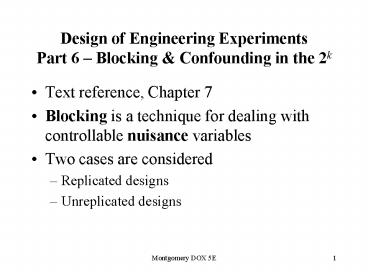Design of Engineering Experiments Part 6 Blocking - PowerPoint PPT Presentation
1 / 11
Title:
Design of Engineering Experiments Part 6 Blocking
Description:
Part 6 Blocking & Confounding in the 2k. Text reference, ... ABCD is Confounded with Blocks ... The two-level factorial can be confounded in 2, 4, 8, ... (2p, p ... – PowerPoint PPT presentation
Number of Views:168
Avg rating:3.0/5.0
Title: Design of Engineering Experiments Part 6 Blocking
1
Design of Engineering ExperimentsPart 6
Blocking Confounding in the 2k
- Text reference, Chapter 7
- Blocking is a technique for dealing with
controllable nuisance variables - Two cases are considered
- Replicated designs
- Unreplicated designs
2
Blocking a Replicated Design
- This is the same scenario discussed previously
(Chapter 5, Section 5-6) - If there are n replicates of the design, then
each replicate is a block - Each replicate is run in one of the blocks (time
periods, batches of raw material, etc.) - Runs within the block are randomized
3
Blocking a Replicated Design
Consider the example from Section 6-2 k 2
factors, n 3 replicates This is the usual
method for calculating a block sum of squares
4
ANOVA for the Blocked DesignPage 288
5
Confounding in Blocks
- Now consider the unreplicated case
- Clearly the previous discussion does not apply,
since there is only one replicate - To illustrate, consider the situation of Example
6-2, Page 248 - This is a 24, n 1 replicate
6
Example 6-4
Suppose only 8 runs can be made from one batch of
raw material
7
The Table of - Signs, Example 6-4
8
ABCD is Confounded with Blocks (Page 294)
Observations in block 1 are reduced by 20
unitsthis is the simulated block effect
9
Effect Estimates
10
The ANOVA
The ABCD interaction (or the block effect) is not
considered as part of the error term The rest of
the analysis is unchanged from Example 7-2
11
Confounding in Blocks
- More than two blocks (page 296)
- The two-level factorial can be confounded in 2,
4, 8, (2p, p gt 1) blocks - For four blocks, select two effects to confound,
automatically confounding a third effect - See example, page 296
- Choice of confounding schemes non-trivial see
Table 7-8, page 298 - Partial confounding (page 299)































